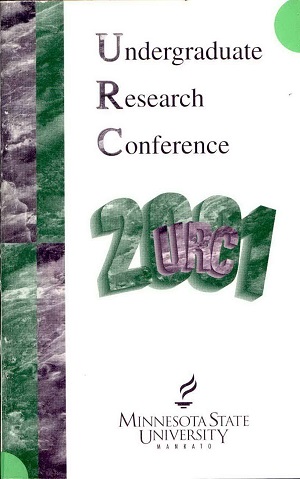Phylogenetic Analysis of Freshwater Sediment Bacteria Cultured from a Phenol Enrichment Microcosm
Location
CSU
Student's Major
Biological Sciences
Student's College
Science, Engineering and Technology
Mentor's Name
Elaine Hardwick
Mentor's Department
Biological Sciences
Mentor's College
Science, Engineering and Technology
Description
Bacterial isolates obtained from Hiniker Pond sediments (North Mankato, MN) were selected for their ability to use phenol as their sole carbon source. Phylogenetic analysis of their 16S rRNA genes will facilitate identification of these isolates. Initially, the isolates were placed into two different microcosms: one containing phenol as the sole carbon source, and one containing no phenol (control group). Every 30 days, the isolates were cultured onto agar containing phenol (M9 + phenol) and a nutrient agar without phenol (control). Morphological results were obtained from those bacteria growing on the phenol enriched media, and biochemical tests of these isolates further aided in the identification of the sediment bacteria. Unique isolates, based on the results of the biochemical tests, were used for phylogenetic analysis of the 16s rRNA. The 16s rRNA was extracted, and PGR (Polymerase Chain Reaction) amplified the rRNA, which was then sent to the University of Minnesota's St. Paul Advanced Genetic Analysis Center (AGAC) for sequencing. The sequence data was then analyzed and the web-based programs BLAST and PHYLIP were used to identify the isolates chosen for sequencing. Any unique 16S rRNA will be contributed to GenBank upon completion of sequence analysis.
Phylogenetic Analysis of Freshwater Sediment Bacteria Cultured from a Phenol Enrichment Microcosm
CSU
Bacterial isolates obtained from Hiniker Pond sediments (North Mankato, MN) were selected for their ability to use phenol as their sole carbon source. Phylogenetic analysis of their 16S rRNA genes will facilitate identification of these isolates. Initially, the isolates were placed into two different microcosms: one containing phenol as the sole carbon source, and one containing no phenol (control group). Every 30 days, the isolates were cultured onto agar containing phenol (M9 + phenol) and a nutrient agar without phenol (control). Morphological results were obtained from those bacteria growing on the phenol enriched media, and biochemical tests of these isolates further aided in the identification of the sediment bacteria. Unique isolates, based on the results of the biochemical tests, were used for phylogenetic analysis of the 16s rRNA. The 16s rRNA was extracted, and PGR (Polymerase Chain Reaction) amplified the rRNA, which was then sent to the University of Minnesota's St. Paul Advanced Genetic Analysis Center (AGAC) for sequencing. The sequence data was then analyzed and the web-based programs BLAST and PHYLIP were used to identify the isolates chosen for sequencing. Any unique 16S rRNA will be contributed to GenBank upon completion of sequence analysis.



